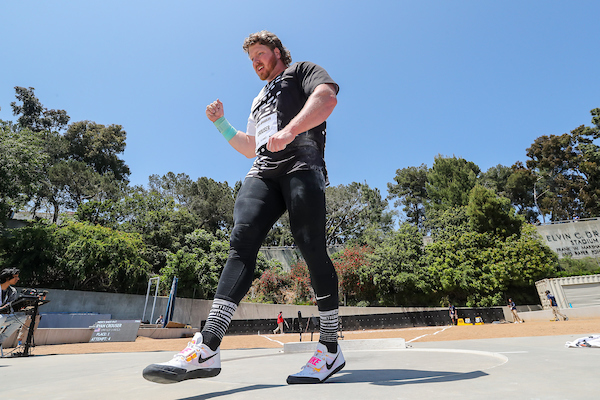This is our third repost from the Sports Examiner, an important Olympic news service founded by Rich Perelman, a long-time Olympic journalist. The following piece was written by David Miller, a guest columnist for The Sports Examiner, and his column is on a potential Olympic Boycott in Paris 2024. It makes for fascinating reading. We encourage all to subscribe to The Sports Examiner. After this column, we will post a subscription offer.
Crouser smashes WR again: 77-3 3/4 at L.A. Grand Prix.
A world-class invitational meet in the Los Angeles area hadn’t occurred since 2008. The last major invitational at UCLA’s Drake Stadium was in 1990 when Randy Barnes set a world record of 23.12 m (75-10 1/4) in the men’s shot put.
On Saturday, Ryan Crouser had the best meet in the history of shot putting, scaring and then surpassing his own world record – and the 77-foot mark – with a staggering fourth throw of 23.56 m (77-3 3/4) at USATF’s L.A. Grand Prix.
This was using his new “step-across” throwing motion – also known as the Crouser Slide – designed to help generate more speed in the ring, and did it ever. Throwing at the north end of the field, in what was originally designed as a practice ring, Crouser nearly hit the concrete retaining wall at the far back of the dirt landing area, way beyond the 22 m marking line.
Crouser was on fire from the start:
● 1: 23.23 m (76-2 3/4), equal-3rd performance all-time
● 2: 23.31 m (76-5 3/4), no. 2 all-time
● 3: 22.94 m (75-3 1/4)
● 4: 23.56 m (77-3 3/4), World Record
● 5: 22.80 m (74-9 3/4)
● 6: 22.86 m (75-0)
He had three of the top six throws in history in the same series, not counting his 23.38 m (76-8 1/2) indoor mark at the Simplot Games on 18 February, which was not ratified as a world record and classified as an “irregular measurement.”
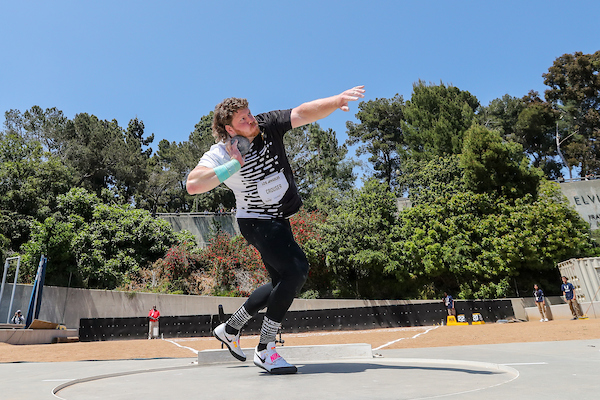
Gold Label track & field meet
May 26, 2023, Los Angeles, USA, photo by Kevin Morris
His six-throw average was a staggering 23.12 m (75-10 1/4), a distance that only two others – Americans Joe Kovacs (2022) and Barnes (1990) – have ever reached once! He was the first to reach 76 feet and now the first to 77.
Just sensational; Crouser said afterward that this was the first time he had been able to get his new technique working in the competition after seeing promising results in training. And he said there is more in the tank.
Former World Champion Tom Walsh of New Zealand was excellent in second at 22.12 m (72-7), but was completely overshadowed.
That was the highlight of an excellent afternoon of track & field, which saw a total of seven world-leading marks:
● Men/1,500 m: 3:31.47, Timothy Cheruiyot (KEN)
● Men/Vault: 5.91 m (19-4 3/4), Mondo Duplantis (SWE) and Sam Kendricks (USA)
● Men/Shot Put: 23.56 m (77-3 3/4), Ryan Crouser (USA) ~ World Record
● Women/400 m: 48.98, Marileidy Paulino (DOM)
● Women/1,500 m: 3:57.84, Diribe Welteji (ETH)
● Women/100 m Hurdles: 12.31, Jasmine Camacho-Quinn (PUR)
● Women/Shot Put: 20.45 m (67-1 1/4), Maggie Ewen (USA)
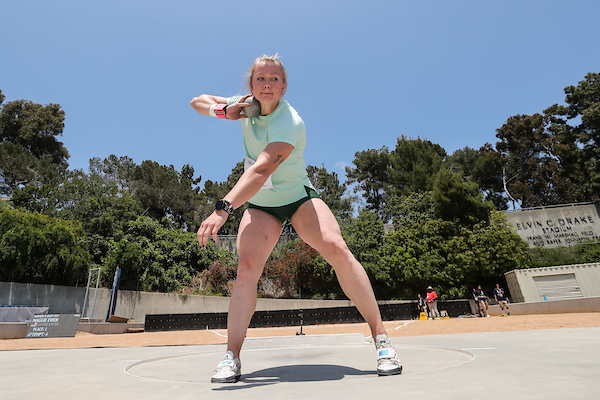
Gold Label track & field meet
May 26, 2023, Los Angeles, USA, photo by Kevin Morris
The men’s and women’s 100 m dashes were much anticipated, even more so when the women’s heats produced a runaway 10.90 win (wind: -0.8 m/s) for Sha’Carri Richardson in the first race and then a 10.88-10.95 win (+1.3) for Marie-Josee Ta Lou (CIV) over American Aleia Hobbs in the second. But none of those three ran in the final, citing injuries or injury concerns, and resurgent Morolake Akinosun won the final in 10.97 (+0.2) over Melissa Jefferson (11.07).
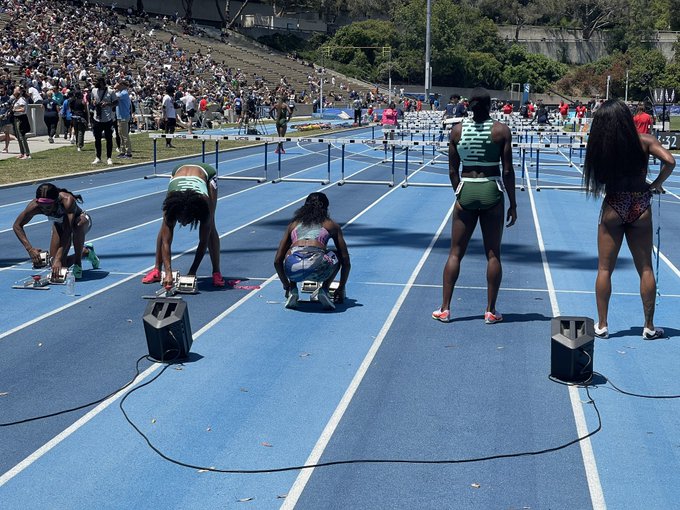
The men’s 100 m was the day’s final race, and super-starter Christian Coleman got out well and had the race in hand at 80 m. But Jamaica’s Ackeem Blake, to Coleman’s left, closed with a rush and got to the line first in a lifetime best of 9.89, no. 3 in the world for 2023. American Cravont Charleston caught Coleman at the tape and got second, with both in 9.91, a lifetime best for Charleston. Both ranked no. 4 in the world at the meeting’s end.
The other straightaway race that had the knowledgeable fans waiting was the women’s 100 m hurdles, and Olympic champ Jasmine Camacho-Quinn did not disappoint with a world-leading 12.31 (-0.2), just 0.05 off her best ever. She took control in mid-race and kept the pressure on to beat a late surge from Keni Harrison (12.35), her fastest since 2017!
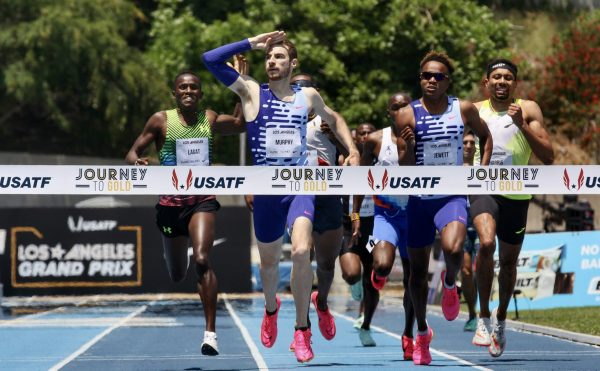
There was a lot to like, including two come-from-behind wins in the men’s 800 m and 1,500 m. American Clayton Murphy smoked the straight to win the 800 m in 1:44.75, no. 4 on the year list. Kenyan Cheruiyot, the 2019 World Champion, took off in the final 100 m to pass countryman Raynold Kipkorir, 18, to win in a world-leading 3:31.47 to 3:32.01. American Hobbs Kessler, 20, also flew down the home straight and got third over Cooper Teare, 3:32.61 to 3:32.74, lifetime bests for both.
The women’s 1,500 m was a runaway for Ethiopia’s Welteji in 3:57.84, her third-fastest ever, with Kate Snowden (GBR) getting a lifetime best at 4:00.04, now no. 3 in 2023, and American Josette Andrews at 4:00.77, another lifetime best, and no. 5 in 2023.
The women’s 800 m saw a late surge from Ajee Wilson of the U.S. that carried her to victory in 1:59.01, no. 4 on the year list, over 2019 World Champion Halimah Nakaayi (1:59.35).
Dominican star Marileidy Paulino ran away with the women’s 400 m in a national record 48.98, ahead of comeback Salwa Eid Naser (BRN: 50.27). American Jenna Prandini ran down former USC Trojan TeeTee Terry to win the 200 m, 22.34-22.44 (+0.5).
Jamaica’s Sean Bailey stormed past 2012 Olympic winner Kirani James (GRN) off the final turn to win the men’s 400 m in 44.43 to 44.50. C.J. Allen of the U.S. continued his hot running in the men’s 400 m hurdles, winning in 47.91, now no. 2 in 2023, a lifetime best and his second race this season under 48 seconds.
World Champion Anderson Peters (GRN) put the men’s javelin to bed early with his winning throw of 83.16 m (272-10) in the first round. China’s Xiaomei Sun won the women’s javelin with her second-round throw of 55.67 m (182-7).
The women’s shot saw the world-leading performance by Ewen, whose 20.45 m (67-1 1/4) moved her to no. 3 all-time U.S. World Champion Chase Ealey was second at 19.98 m (65-6 3/4).
It was a wonderful meet on the track and on the field (and shot circle), but there was significance well beyond the results.
2.
Grand Prix confirms L.A. market and Drake Stadium appeal.
In many track and field circles, there was as much interest in the attendance, optics, and feel of the L.A. Distance Classic on Friday and the L.A. Grand Prix on Saturday as there was in the events themselves.
At least from Saturday’s L.A. Grand Prix, there are some noteworthy conclusions to be drawn:
● UCLA’s Drake Stadium, once one of the premiers showcases for the sport in the U.S., shined brightly as an excellent competitive facility, with world-class performances in every event and more than a dozen stadium records. Not a huge surprise for the first high-end invitational there in 33 years, but still great to see.
● The attendance was a critical measure of success for this meet, and while the 11,142-seat facility was hardly full, the crowd was good. Announced at 7,246, there were actually about 4,500 there on Saturday, as shown by this photo taken after the men’s 800 m (some empty sections at the right side of the image are not shown):

But this was the best crowd for a meet in the Los Angeles area since the 2005 adidas Track Classic at the (then) Home Depot Center in Carson. And, given the indifferent promotion of the meet, was a concrete demonstration that Los Angeles is still – after all these years – a very viable market for track & field.
● The meeting had a lot of important eyes on it. Underwritten by Southern California-based Internet Brands (WebMD, CarsDirect, and many others), there was an evaluation team from World Athletics on-site and a member of its Executive Board. New U.S. Olympic & Paralympic Committee President Gene Sykes, also an LA28 Olympic & Paralympic Games Organizing Committee board member, was in attendance.
What they saw was an unevenly staged meet, beginning with the Friday night L.A. Distance Classic, a meet designed to create fast races for qualifying purposes, along with a few field events.
It was cold and dreary, and this hurt the potentially-exciting women’s vault, which saw Olympic and World champ Katie Moon no-height, but with Worlds silver medalist Sandi Morris winning at 4.61 m (15-1 1/2), beat Canada’s Alysha Newman on misses.
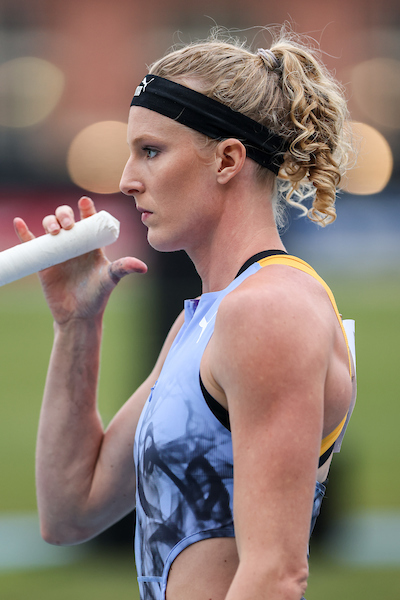
track & field meet
May 26, 2023, Los Angeles, USA, photo by Kevin Morris
The men’s and women’s hammer was held in the afternoon, with only modest public address support, so the dramatic, fifth-round, national-record win by Canada’s Cam Rogers at 78.62 m (257-11) over World Champion Brooke Andersen of the U.S. (76.06 m/249-6) was hard to follow. Rogers moved to no. 2 in the world this season, and former World Champion DeAnna Price of the U.S. moved to no. 3 in third place at 75.89 m (248-11).
Poland’s Wojciech Nowicki won the men’s hammer in the sixth round with a 77.18 m (253-2) toss to edge American Rudy Winkler (77.17 m/253-2). Also essentially went unnoticed.
Same in the men’s and women’s discus, where Olympic gold medalist Valarie Allman has rarely noted prior to her throws; she set the field down with a first throw of 68.39 m (224-4), beating Cuba’s Yaime Perez (63.63 m/209-9). Jamaica went 1-2 in the men’s disc, with Traves Smikle upending 2019 Worlds silver medalist Fedrick Dacres, 67.06 m (220-0) to 64.51 m (211-7).
The running events concentrated on the distances, of course, and the cool weather made for excellent conditions. Not as good, however, was that the runners were in the dark as soon as the sun went down because the 1999 renovation of Drake Stadium installed lighting for the soccer field and not on the track.
The 1,200 or so spectators could barely see Ahmed Jaziri of Tunisia won the men’s Steeple at 8:17.64, no. 2 in 2023, with American Isaac Updike just behind at 8:17.96 (no. 3). But the women’s 5,000 m – won by Emily Lipari of the U.S. with a 69.34 last lap in 15:08.87 – was hard to follow and the excellent men’s 5,000 was literally in the dark.
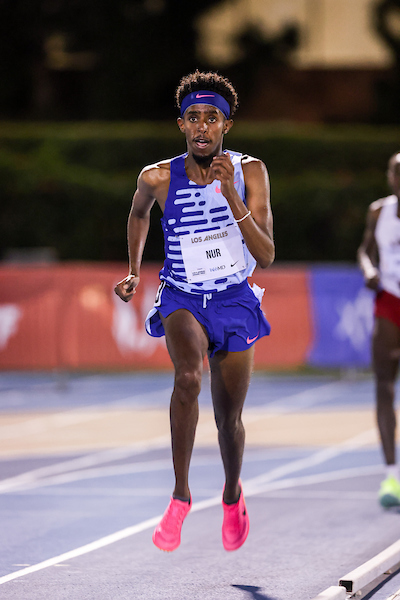
track & field meet
May 26, 2023, Los Angeles, USA, photo by Kevin Morris
Too bad because Abdi Nur scored an impressive lifetime best of 13:05.17, beating Edwin Kurgat (KEN: 13:08.46) and Morgan Beadlescomb (USA: 13:08.82); the top 12 all broke 13:20.
Crouser’s world-record performance was held at the north end circle, used by UCLA for practice and now for its low-key home meets. But when the field was re-designed in 1999, shot put circles were installed on the infield, including one just beyond the finish line, which would have been right in front of most of the spectators. But perhaps no one knew about it.
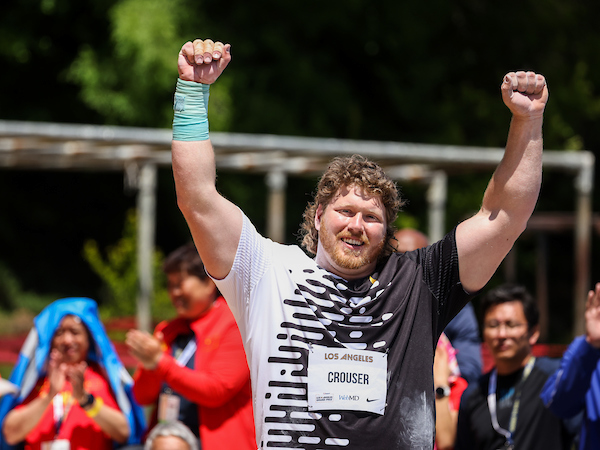
Gold Label track & field meet, photo by Kevin Morris
May 26, 2023, Los Angeles, USA
The meet is hoped to be an annual event in Los Angeles, so these issues and others can be addressed in the future. The enthusiasm of Saturday’s attendees sent a message that Los Angeles is a very viable future site for more high-quality meets like this one.
The Sports Examiner is your all-in-one coverage source for the key competitive, economic, and political forces shaping elite sports and the Olympic Movement. To get The Sports Examiner by e-mail, sign up here: http://www.thesportsexaminer.

